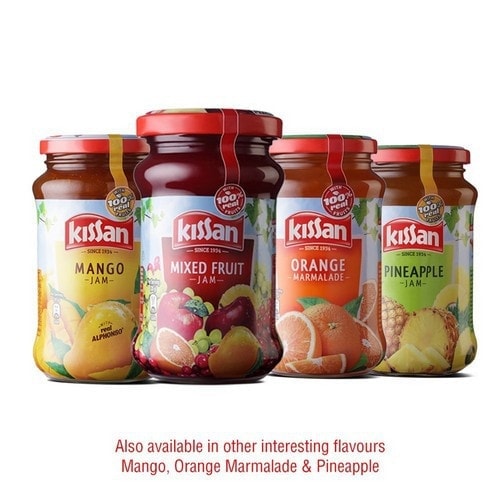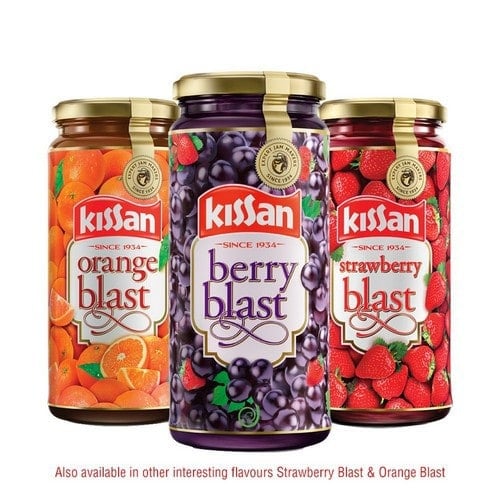Kissan Jam is a flagship product of the Indian conglomerate Kissan Group. The company which was established in the year 1935 was owned by the UB Group.After the year 1993, the brand was taken over by HUL following which the brand has undergone a makeover.Kissan makes fruit juices, jams, squashes and other canned foods.
Kissan takes a lot of caution in the sourcing of their raw material and they have partnered with agriculturists from various parts of the country to ensure that their raw materials are of top quality and fresh. The brands have been able to associate itself successfully with Indian sentiments and capture the minds of their target audience which is primarily children. Kissan has an annual revenue of 7 million USD and employs around 7300 employees.
Table of Contents
Strengths in the SWOT analysis of Kissan Jam
The following are the strengths of Kissan Jam:
- Popularity with target segment: Kissan Jam target children and most of their products like squashes, jams and ketchup caters to this group. Through an alluring taste, right ingredients and string advertising strategy Kissan has been successful in connecting to this segment very strongly.
- Focus on core products: Kissan has always been focused on their core products namely jam and ketchup. Within these also Kissan has derived top sellers namely the Kissan mixed fruit jam and the tomato ketchup and most of their product innovation has been by transformation of ingredients keeping the core product the same.
- Consistent Communication based on mixed fruit jam: The promotional strategy and advertisements of Kissan have always been centred on their top sellers – Ketchup and Mixed Fruit Jam. The company has always been consistent in their marketing communication which focuses on Trust, natural goodness, health, versatile and sweet taste. The brand has also built a strong association with the colour red.
- Sustainable Procurement: Kissan sources their raw materials through Public Private Partnership (PPP) in Maharashtra where they procure sustainable produce from smallholder farmers, tomato paste processor, Maharashtra government and the agri-input supply companies. This gave them a competitive edge over rivals and also made them independent of import of the raw materials which was the strategy used by the competition.
- Kissan Recipes: In order to take innovation to the next level and to improve customer retention, Kissan features recipes which are made using Kissan Products. This has resulted in capturing the attention as well as winning the trust of mothers who are the primary buyers of Kissan Products.
Weaknesses in the SWOT analysis of Kissan Jam
Some of the key weaknesses of Kissan Jam are :
- The excessive popularity of mixed fruit Jam: Kissan has always been the key player in the jam segment, but most of their popularity was centred around the mixed fruit jam. This has led to a loss of face for other flavours like orange and mango and these continue to be resting on shelves while the mixed fruit flavour has a lot of takers.
- Poor Innovation: The Kissan Jam has been the same for ages and there is not much of innovation happening in this other than some cosmetic changes in packaging and some new recipes which offers the customers more options for using the jam. The innovation in the product is almost non-existent with the result that there is a risk that customers may get bored with the same taste.
- No product launches: While rivals like Nestle, Brittania and even some local players have launched new products like cheese spreads and chocolate spreads, Kissan still continues to depend on fruit flavours for its jams and this is affecting their image.
Opportunities in the SWOT analysis of Kissan Jam
Some of the opportunities include :
- Demand for jam: Earlier jam was seen as an accompaniment to bread and was a part of the Western breakfast.But through some novel promotional campaigns and recipes, Kissan has been able to make it an integral part of the Indian breakfast by associating it with parathas and idlis. This, in turn, has resulted in increasing the demand for jams.
- Lack of time: As more mothers have started joining the workforce, morning has become hectic and the demand for quick yet healthy and tasty breakfast options is the need for the hour. This is a huge opportunity for Kissan jam which fits this need perfectly.
Threats in the SWOT analysis of Kissan Jam
Some of the threats include:
- Competition: Some of the major competitors of Kissan Jam are Amul Cheese Spread, Britannia Cheese spread, Hersheys Chocolate Spread and Nutella.
Liked this post? Check out the complete series on SWOT

